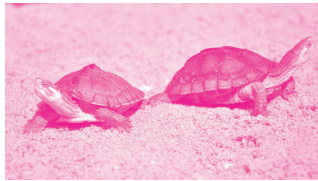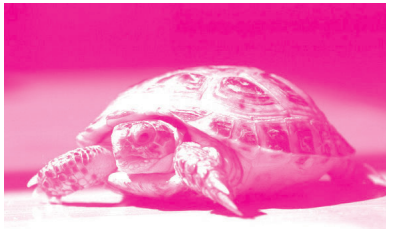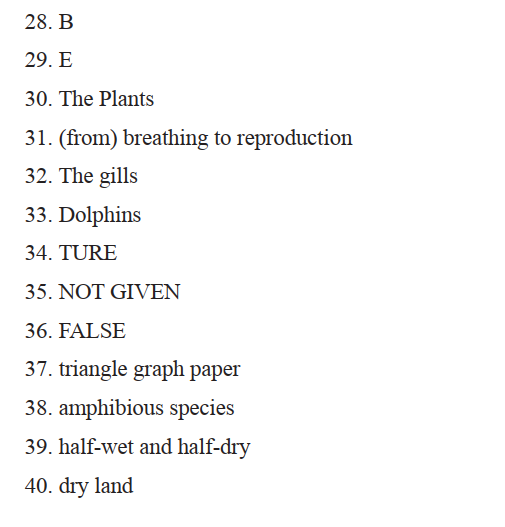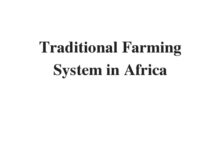Table of Contents
Passage
The word turtle is a tiresome example of Bernard Shaw’s observation: England and America are two countries divided by a common language. In British usage, turtles live in water and tortoises on land. For Americans, tortoises are those turtles that live on land.
A There is good evidence that the most recent common ancestor of all today’s tortoises, including those on the mainlands of America, Australia, Africa and Eurasia, as well as the giants of Galapagos ( 加拉帕戈斯群岛 ),Aldabra, the Seychelles and other oceanic islands, was itself a land tortoise.)In their recent ancestry, to misquote Stephen Hawking, it’s tortoises all the way down. The various giant tortoises of the Galapagos Islands are certainly descended from South American land tortoises.
B If you go back far enough everything lived in the sea: watery alma mater of all life. At various points in evolutionary history, enterprising individuals within many different animal groups moved out onto the land, sometimes even to the most parched ( 炙热的)deserts, taking their own private sea water with them in blood and cellular fluids. In addition to the reptiles, birds, mammals and insects which we see all around us, other groups that have succeeded out of water include scorpions, snails, crustaceans such as woodlice and land crabs, millipedes and centipedes, spiders and their kin and various worms. And we mustn’t forget the plants, without whose prior invasion of the land none of the other migrations could have happened.

C Moving from water to land involved a major redesign of every aspect of life, from breathing to reproduction: it was a great trek through biological space. Nevertheless, with what seems almost like perversity, a good number of thoroughgoing land animals later turned around, abandoned their hard-earned terrestrial re-tooling, and trooped back into the water again. Seals and sea lions (such as the breathtakingly tame Galapagos sea lion) have only gone part-way back. They show us what the intermediates might have been like, on the way to extreme cases such as whales and dugongs ( 海 牛 ) . Whales (including the small whales we call dolphins), and dugongs with their close cousins the manatees ( 海牛一种 ), ceased to be land creatures altogether and reverted to the full marine habits of their remote ancestors. They don’t even come ashore to breed. They do, however, still breathe air, having never developed anything equivalent to the gills of their earlier marine incarnation.
D Other animals that have returned from land to water are pond snails, water spiders, water beetles, Galapagos flightless cormorants, penguins (Galapagos has the only penguins in the northern hemisphere), marine iguanas (found nowhere but Galapagos) and turtles (abundant in the surrounding waters).
E Turtles went back to the sea much longer ago. They are, in one respect, less fully given back to the water than whales or dugongs, for turtles still lay their eggs on beaches. Like all vertebrate returnees to the water, they breathe air, but in this department they go one better than whales. Some turtles extract additional oxygen from the water through a pair of chambers at the rear end, richly supplied with blood vessels. One Australian river turtle, indeed, gets the majority of its oxygen by breathing, as an Australian would not hesitate to say, through its arse.
F There is evidence that all modern turtles are descended from a terrestrial ancestor who lived before most of the dinosaurs. There are two key fossils called Proganochelys quenstedti and Palaeochersis talampayensis dating from early dinosaur times, which appear to be close to the ancestry of all modern turtles and tortoises. You might wonder how we tell whether fossil animals, especially if only fragments are found, lived on land or in water. Sometimes it’s pretty obvious. Ichthyosaurs ( 鱼龙)were reptilian contemporaries of the dinosaurs, with fins and streamlined bodies. The fossils look like dolphins and they surely lived like dolphins, in the water. With turtles it is a little less obvious. One neat way to tell is by measuring the bones of their forelimbs.
G Walter Joyce and Jacques Gauthier, at Yale University, took three key measurements in the arm and hand bones of 71 species of living turtles and tortoises. They used a kind of triangular graph paper to plot the three measurements against one another. Lo and behold, all the land tortoise species formed a tight cluster of points in the upper part of the triangle; all the water turtles cluster in the lower part of the triangular graph. There was no overlap, except when they added some species that spend time in both water and land. Sure enough, these amphibious species show up, on the triangular graph, half way between the “wet cluster” and the “dry cluster”. Well then, to the obvious next step: where do the fossils fall? The hands of Palaeochersis quenstedti and Palaeochersis talampayensis leave us in no doubt. Their points on the graph are right in the thick of the dry cluster. Both these fossils were dry-land tortoises. They come from the era before our turtles returned to the water.

H You might think, therefore, that modern land tortoises have probably stayed on land ever since those early terrestrial times, as most mammals did after a few of them went back to sea. But apparently not. If you draw out the family tree of all modern turtles and tortoises, nearly all the branches are aquatic. Today’s land tortoises constitute a single branch, deeply nested among branches consisting of aquatic turtles. This suggests that modern land tortoises have not stayed on land continuously since the time of P. quenstedti and P. talampayensis ( 两种远古海龟 ). Rather, their ancestors were among those who went back to the water, and they then re-emerged back onto the land in (relatively) more recent times.
I Tortoises therefore represent a remarkable double return. In common with all mammals, reptiles and birds, their remote ancestors were marine fish and before that various more or less worm-like creatures stretching back, still in the sea, to the primeval bacteria. Later ancestors lived on land and stayed there for a very large number of generations. Later ancestors still evolved back into the water and became sea turtles. And finally they returned yet again to the land as tortoises, some of which, though not the Galapagos giants, now live in the driest of deserts.
Questions
Questions 28-29 Choose the TWO correct letters from the A-E Write your answers in boxes 28-29 on your answer sheet.
What are the two amazing features for turtles?
A Their terrestrial ancestors lived as contemporaries of the dinosaurs,
B Some turtles can breathe oxygen from the body part in the rear end.
C The fossils of ancient turtles are with fins and streamlined bodies
D They don’t even come ashore to breed.
E They had evolved back to the water, and they then re-evolved back onto the land
Questions 30-33 Answer the questions below. Choose NO MORE THAN THREE WORDS AND/OR A NUMBER from the passage for each answer.
30 What have to be the first migrated species of lives which ensure others evolving from the sea onto the land?
31 Which transfer can be a significant leap as evolving from water to land is concerned?
32 Which is, being absent in whales or dolphins, the one of the proofs to show they may have evolved back from land to the sea.
33 What kind of animal show that if the fossil looks like those, it indicates the species is living in the sea even in ancient time?
Questions 34-36 Do the following statements agree with the information given in Reading Passage? In boxes 34-36 on your answer sheet, write
TRUE if the sataement agrees with the information
FALSE if the statement contradicts the information
NOT GIVEN if there is no information on this
34 Scientists can tell whether a species is living in the sea or land by examining the fossils.
35 The fossils can not serve as definite proofs for determining where one ancient species lived in dinosaur period from another.
36 Modern land tortoises are one group of turtles that stayed on land ever since and all through the ancient time.
Questions 37-40 Complete the following summary of the paragraphs of Reading Passage, using no more than Three words from the Reading Passage for each answer. Write your answers in boxes 37-40 on your answer sheet.
Walter Joyce and Jacques Gauthier, at Yale University, took three key measurements in the arm and hand bones of a group of living turtles and tortoises. They used 37 …………….. on which to draw and mark the data collected. It was found that all the land tortoise and the water turtles species formed cluster of points in the different parts of the patterned graphs obtained; yet the clusters formed in those 38 …………….. indicate there were kind of situation like between 39 …………….. As a result, the fossils of both these ancient turtles’limbs and with their clusters show us both these ancient creatures were living in 40 ……………..
Answers



